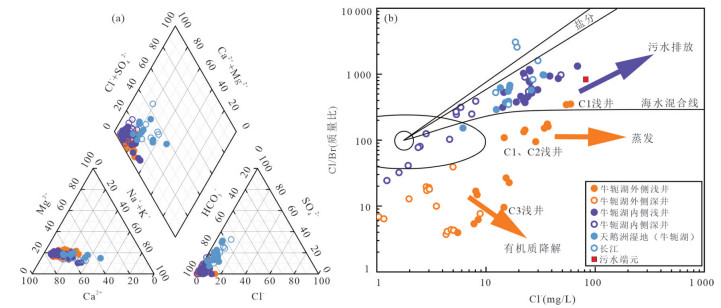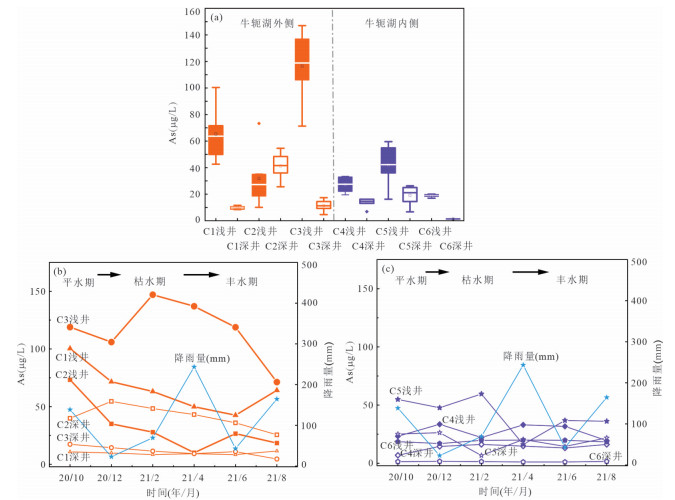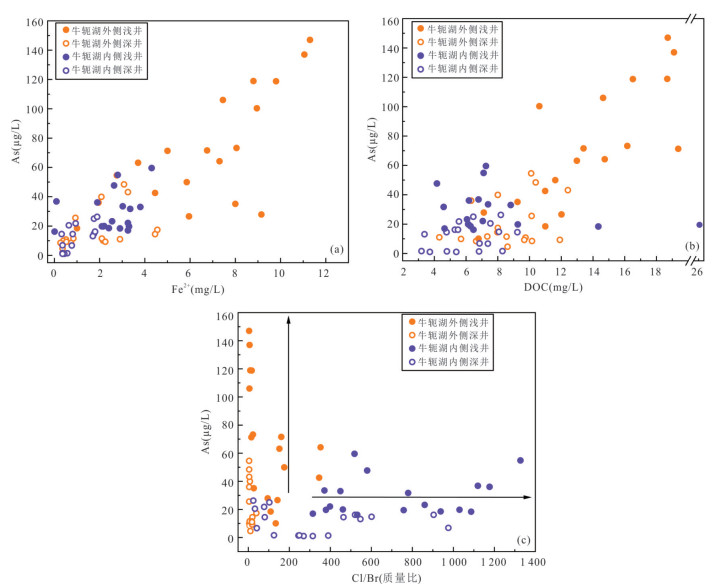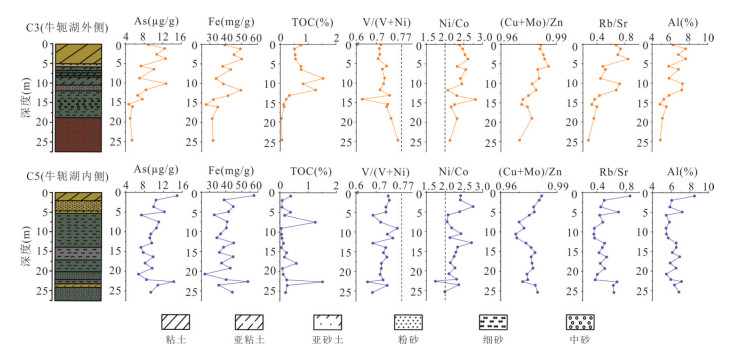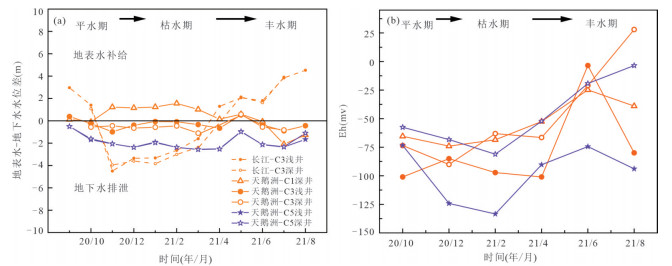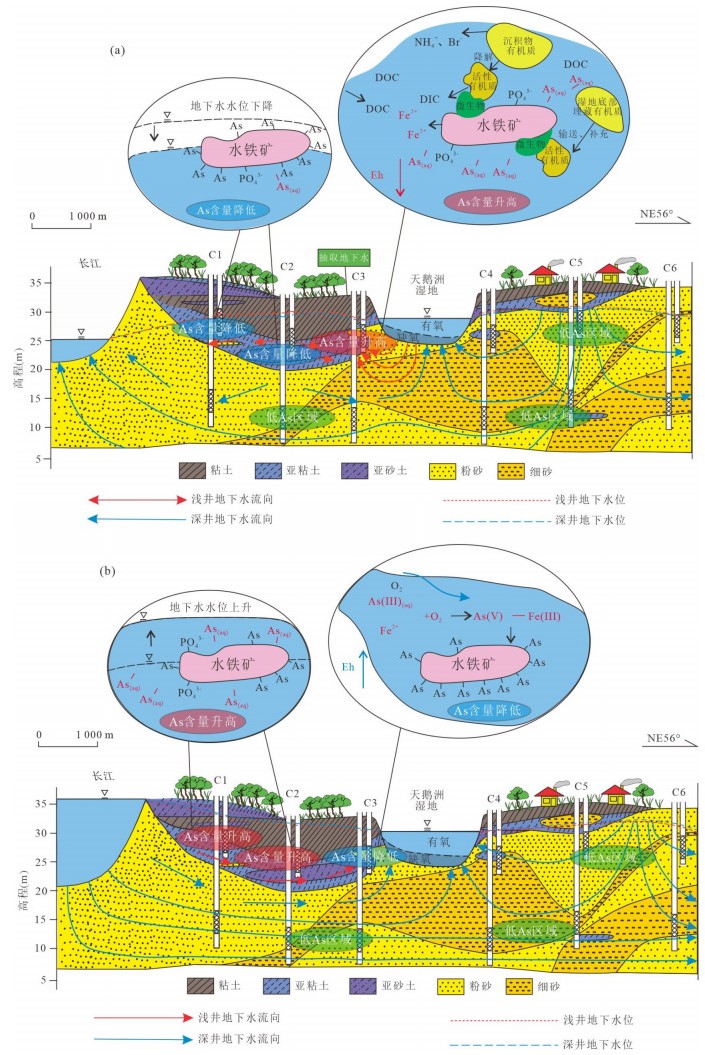Spatial-Temporal Distribution of Arsenic in Groundwater System in Tian-E-Zhou Wetland of the Yangtze River and Its Controlling Mechanism
-
摘要: 高砷地下水不仅直接危害供水安全,还可通过与湿地之间的交互作用,影响湿地水质进而威胁湿地生态安全.长江中游河湖平原已被报道广泛分布有高砷地下水,而位于长江中游故道区域的天鹅洲湿地地下水中砷的空间分布特征尚不明确,湿地与地下水的交互作用对地下水中砷季节性动态的控制机理尚不明确.本研究在天鹅洲湿地采集2个水文地质钻孔的35件沉积物样品、12个分层监测井不同季节的共72组地下水样和18组地表水样,通过水位-水化学监测、沉积物地球化学组成分析和砷、铁形态表征探究天鹅洲湿地地下水中砷的时空分布规律及控制机理.研究发现天鹅洲湿地地下水砷含量为1.08~147 μg/L,牛轭湖外侧浅井(10 m)地下水砷含量普遍高于深井(25 m)和牛轭湖内侧浅井(10 m)、深井(25 m)地下水,枯水期和平水期的砷含量高于丰水期.牛轭湖外侧浅层地下水系统具有更厚的粘土、亚粘土沉积,沉积物中总砷、强吸附态砷和易还原的铁氧化物的含量更多,吸附砷的水铁矿等无定形铁氧化物还原性溶解导致砷释放进入地下水中.枯水期天鹅洲湿地底部向牛轭湖外侧浅层含水层输送不稳定的有机质,使天鹅洲湿地地下水-地表水界面成为砷释放的热点区域.丰水期时牛轭湖外侧含水层受长江补给的影响,还原环境发生改变使地下水中的砷和铁被氧化固定从而不利于砷向地下水释放.Abstract: High arsenic groundwater not only directly endangers water supply safety, but also affects the water quality of wetlands and thus threatens the ecological safety of wetlands through the long-term interactions between groundwater and surface water. The spatial distribution of arsenic in groundwater in the Tian-E-Zhou wetland in the middle reach of the Yangtze River has been reported to be wide, but the spatial distribution characteristics of arsenic in groundwater in the Tian-E-Zhou wetland in the middle reach of the Yangtze River are still not clear, and the control mechanism of the interaction between the wetland and groundwater on the seasonal dynamics of arsenic in groundwater is not clear. In this study, 35 sediment samples from 2 hydrogeological boreholes, a total of 72 sets of groundwater samples and 18 sets of surface water samples from 12 stratified monitoring wells in different seasons were collected in the Tian-E-Zhou wetland, and the spatial-temporal distribution patterns and control mechanisms of arsenic in groundwater in the Tian-E-Zhou wetland were investigated by water level-water chemistry monitoring, sediment geochemical composition analysis and arsenic-iron morphological characterization. It was found that the arsenic content of groundwater in the Tian-E-Zhou wetland ranged from 1.08 to 147.00 μg/L. The arsenic content of groundwater in shallow wells (10 m) under the outer side of the Oxbow Lake was generally higher than that in deep wells (25 m) and groundwater under the inner side of Oxbow Lake, and the arsenic content in the non-monsoon was higher than that in the monsoon. The shallow groundwater system under the outer side of the Oxbow Lake has thicker clayey and sub-clayey deposits with higher total arsenic, strongly adsorbed state arsenic and easily reduced iron oxides in the sediments, and reductive dissolution of amorphous iron oxides such as ferrihydrite minerals that adsorb arsenic leads to the release of arsenic into the groundwater. The transport of reactive organic matters from the bottom of the Tian-E-Zhou wetland to the shallow aquifer outside the Oxbow Lake during the non-monsoon makes the groundwater-surface water interface of the Tian-E-Zhou wetland a hot spot area for arsenic release. During the monsoon, the aquifer on the outer side of the Oxbow Lake is influenced by the recharge of the Yangtze River, and the reduction environment is changed so that the arsenic and iron in the groundwater are fixed by oxidation, which is detrimental to the release of arsenic to the groundwater.
-
图 2 天鹅洲湿地地下水、地表水Piper三线图(a)及Cl/Br图示(b)
Cl/Br图示中的红色小正方形代表污水端元,其数据来源于美国的一处化粪池的渗滤液Panno et al.(2006),海水混合线、稀释补给端元等参照McArthur et al.(2012)
Fig. 2. Piper diagram (a) of groundwater and surface water and Cl/Br diagram (b) of the Tian-E-Zhou wetland
表 1 天鹅洲水样水化学统计表
Table 1. Statistics of hydrochemistry of the Tian-E-Zhou water samples
指标 牛轭湖外侧浅井(10 m) 牛轭湖外侧深井(25 m) 牛轭湖内侧浅井(10 m) 牛轭湖内侧深井(25 m) 天鹅洲湿地(牛轭湖) 长江 最大值 最小值 中位数 最大值 最小值 中位数 最大值 最小值 中位数 最大值 最小值 中位数 最大值 最小值 中位数 最大值 最小值 中位数 pH 7.46 6.92 7.12 7.54 6.93 7.12 7.68 6.73 7.40 7.58 6.72 7.20 8.62 7.76 8.15 8.31 7.79 8.05 Eh(mV) ‒3.50 ‒103 ‒88.0 31.0 ‒91.3 ‒66.0 ‒46.7 ‒133 ‒89.5 ‒3.50 ‒101 ‒56.0 89.8 38.7 66.2 106 3.00 43.05 EC(µs/cm) 1 275 606 856 1 149 840 974.5 827 413 737 897 648 785 464 325 384 413 322 371 TDS(mg/L) 897 402 540 782 577 654 541 261 478 675 396 523 334 218 255 265 188 237 DOC(mg/L) 19.4 6.78 13.2 12.4 4.31 8.58 25.6 4.16 6.62 9.23 3.19 6.00 14.3 4.35 5.71 4.08 0.81 3.19 NH4-N(mg/L) 11.9 0.37 9.35 1.35 0.75 0.89 8.60 1.85 3.43 3.10 0.57 0.74 0.41 0.09 0.19 0.96 0.05 0.22 K(mg/L) 5.95 2.90 4.74 4.19 2.86 3.7 9.56 3.27 4.71 3.5 2.66 3.13 6.62 4.30 5.87 3.02 2.42 2.76 Na(mg/L) 57.6 15.7 33.4 52.6 11.8 24.2 57.4 5.77 24.6 41.8 6.29 18.8 56.7 6.68 15.3 33.6 11.2 22.5 Ca(mg/L) 173 87.3 116 217 149 178 141 51.2 113 170 105 130 68.0 38.5 49.2 52.6 47.6 48.6 Mg(mg/L) 63.8 25.8 40.2 52.1 34.8 43.1 39.9 10.2 32.3 41.9 29.2 34.1 20.7 13.8 15.89 12.11 10.31 11.91 HCO3-(mg/L) 896 340 583 868 700 766 553 298 514 649 459 561 237 155 206 159 136 148 SO42-(mg/L) 71.5 ND 27.3 38.3 ND 13.7 54.7 ND 25.4 118 0.78 38.0 93.6 17.9 37.2 81.0 17.9 49.0 NO3 -(mg/L) 0.18 ND ND ND ND ND 0.05 ND ND 0.73 ND ND 6.29 ND 0.32 11.8 0.54 7.16 Cl -(mg/L) 59.6 5.51 16.3 8.83 0.70 3.02 68.9 14.2 24.4 48. 6 1.24 5.62 33.8 6.15 16.0 29.9 12.3 18.9 Br(mg/L) 1.53 0.14 0.27 1.19 0.13 0.17 0.06 0.02 0.05 0.05 0.02 0.04 0.05 0.02 0.04 0.05 0.01 0.02 Cl/Br 353 3.95 94.5 39.2 3.73 6.76 1 327 315 669 976 24.4 259 977 152 563 3 066 348 1 217 P(µg/L) 578 18.9 97.3 239 23 131 590 ND 69.4 368 3.96 102 117 33.13 43.7 286 62.5 114 As(µg/L) 147 10.1 67.8 54.6 4.62 11.6 59.6 16.2 22.7 26.3 1.08 13.8 4.68 2.35 3.25 1.92 1.49 1.83 Fe(mg/L) 12.8 1.36 7.75 4.81 0.36 2.05 4.34 0.01 2.48 2.12 0.03 0.64 0.13 0.01 0.03 0.05 0.01 0.02 Fe2+(mg/L) 11.3 1.00 7.38 4.55 0.27 2.02 4.30 0.01 2.72 1.89 ND 0.71 ‒ ‒ ‒ ‒ ‒ ‒ S2-(mg/L) 307 ND 38.5 46.0 ND 5.00 276 ND 33.5 323 ND 6.00 ‒ ‒ ‒ ‒ ‒ ‒ 注:“ND”表示低于检测限,“‒”代表数据未获取. -
Birch, G.F., Matthai, C., Fazeli, M.S., et al., 2004. Efficiency of a Constructed Wetland in Removing Contaminants from Stormwater. Wetlands, 24(2): 459-466. https://doi.org/10.1672/0277-5212(2004)024[0459:EOACWI]2.0.CO;2 Bridge, J. S., 2003. Rivers and Floodplains. Blackwell, Oxford, 504. Bottino, M. L., Fullagar, P. D., 1968. The Effects of Weathering on Whole-Rock Rb-Sr Ages of Granitic Rocks. American Journal of Science, 266(8): 661-670. doi: 10.2475/ajs.266.8.661 Chakraborti, D., Singh, S. K., Rahman, M. M., et al., 2018. Groundwater Arsenic Contamination in the Ganga River Basin: A Future Health Danger. International Journal of Environmental Research and Public Health, 15(2): E180. https://doi.org/10.3390/ijerph15020180 Deng, Y., Zheng, T., Wang, Y., et al., 2018. Effect of Microbially Mediated Iron Mineral Transformation on Temporal Variation of Arsenic in the Pleistocene Aquifers of the Central Yangtze River Basin. The Science of the Total Environment, 619/620: 1247-1258. https://doi.org/10.1016/j.scitotenv.2017.11.166 Deng, Y.M., 2008. Geochemical Processes of High Arsenic Groundwater System at Western Hetao Basin (Dissertation). China University of Geosciences, Wuhan (in Chinese with English abstract). Donselaar, M. E., Bhatt, A. G., Ghosh, A. K., 2017. On the Relation between Fluvio-Deltaic Flood Basin Geomorphology and the Wide-Spread Occurrence of Arsenic Pollution in Shallow Aquifers. The Science of the Total Environment, 574: 901-913. https://doi.org/10.1016/j.scitotenv.2016.09.074 Du, Y., Deng, Y., Ma, T., et al., 2018. Hydrogeochemical Evidences for Targeting Sources of Safe Groundwater Supply in Arsenic-Affected Multi-Level Aquifer Systems. The Science of the Total Environment, 645: 1159-1171. https://doi.org/10.1016/j.scitotenv.2018.07.173 Duan, Y., Gan, Y., Wang, Y., et al., 2017. Arsenic Speciation in Aquifer Sediment under Varying Groundwater Regime and Redox Conditions at Jianghan Plain of Central China. The Science of the Total Environment, 607/608: 992-1000. https://doi.org/10.1016/j.scitotenv.2017.07.011 Fan, B.J., Shi, L., Yang, J., et al., 2022. Sedimentary Environment of Lacustrine Organic Matter in the Central Ordos Basin. Oil & Gas Geology, 43(3): 648-657 (in Chinese with English abstract). Fan, H.C., Sun, X.L., Du, Y., et al., 2021. Influence of Different Groundwater End-Members on 222Rn Mass Balance Model Used to Quantify the Lacustrine Groundwater Discharge. Safety and Environmental Engineering, 28(3): 71-77 (in Chinese with English abstract). Fendorf, S., Nico, P. S., Kocar, B.D., 2010. Arsenic Chemistry in Soils and Sediments. Developments in Soil Science, 34: 357-378. https://doi.org/10.1016/S0166-2481(10)34012-8 Ghosh, D., Bhadury, P., 2018. Microbial Cycling of Arsenic in the Aquifers of Bengal Delta Plains (BDP). Advances in Soil Microbiology: Recent Trends and Future Prospects. Springer, Singapore, 91-108. https://doi.org/10.1007/978-981-10-6178-3_5 Ghosh, D., Kumar, S., Donselaar, M. E., et al., 2021. Organic Carbon Transport Model of Abandoned River Channels: A Motif for Floodplain Geomorphology Influencing Biogeochemical Swaying of Arsenic. The Science of the Total Environment, 762: 144400. https://doi.org/10.1016/j.scitotenv.2020.144400 Guénet, H., Davranche, M., Vantelon, D., et al., 2016. Evidence of Organic Matter Control on as Oxidation by Iron Oxides in Riparian Wetlands. Chemical Geology, 439: 161-172. https://doi.org/10.1016/j.chemgeo.2016.06.023 Guo, H.M., Guo, Q., Jia, Y.F., et al., 2013. Chemical Characteristics and Geochemical Processes of High Arsenic Groundwater in Different Regions of China. Journal of Earth Sciences and Environment, 35(3): 83-96 (in Chinese with English abstract). Guo, H.M., Gao, Z.P., Xiu, W., 2022. Research Status and Trend of Coupling between Nitrogen Cycle and Arsenic Migration and Transformation in Groundwater Systems. Hydrogeology & Engineering Geology, 49(3): 153-163 (in Chinese with English abstract). Harvey, C. F., Swartz, C. H., Badruzzaman, A. B., et al., 2002. Arsenic Mobility and Groundwater Extraction in Bangladesh. Science, 298(5598): 1602-1606. https://doi.org/10.1126/science.1076978 Havril, T., Tóth, Á., Molson, J. W., et al., 2018. Impacts of Predicted Climate Change on Groundwater Flow Systems: Can Wetlands Disappear Due to Recharge Reduction?. Journal of Hydrology, 563: 1169-1180. https://doi.org/10.1016/j.jhydrol.2017.09.020 Hiemstra, T., 2015. Formation, Stability, and Solubility of Metal Oxide Nanoparticles: Surface Entropy, Enthalpy, and Free Energy of Ferrihydrite. Geochimica et Cosmochimica Acta, 158: 179-198. https://doi.org/10.1016/j.gca.2015.02.032 Hopenhayn, C., 2006. Arsenic in Drinking Water: Impact on Human Health. Elements, 2(2): 103-107. https://doi.org/10.2113/gselements.2.2.103 Hu, R.M., 2021. Distribution Characteristics of Trace Elements in the Distribution Characteristics of Trace Elements in the Sediments of Shengjinhu Lake and Their Environmental Implications (Dissertation). Anhui University, Hefei (in Chinese with English abstract). Huang, Y.W., Du, Y., Xu, Y., et al., 2020. Source and Enrichment Mechanism of Ammonium in Shallow Confined Aquifer in the West of Dongting Plain. Bulletin of Geological Science and Technology, 39(6): 165-174 (in Chinese with English abstract). Jiang, Y.M., 2006. Investigation of Aquatic Ecology and Researches on the Emergy Analysis of Tian'e-zhou and Hei-wa-wu Oxbows of the Yangtze River (Dissertation). Huazhong Agricultural University, Wuhan (in Chinese with English abstract). Jones, B., Manning, D. A. C., 1994. Comparison of Geochemical Indices Used for the Interpretation of Palaeoredox Conditions in Ancient Mudstones. Chemical Geology, 111(1-4): 111-129. https://doi.org/10.1016/0009-2541(94)90085-X Keon, N. E., Swartz, C. H., Brabander, D. J., et al., 2001. Validation of an Arsenic Sequential Extraction Method for Evaluating Mobility in Sediments. Environmental Science & Technology, 35(13): 2778-2784. https://doi.org/10.1021/es001511o Li, C., Shu, J.S., Xu, F., et al., 2013. The Analytical Development of Low-Temperature Particulate Fe Speciation. Earth Science, 38(3): 454-460 (in Chinese with English abstract). Li, D., Deng, Y.M., Du, Y., et al., 2021. Isotopic Indication of Spatial Heterogeneity of Arsenic in Shallow Groundwater of Middle Yangtze River Lacustrine Plain. Earth Science, 46(12): 4492-4502 (in Chinese with English abstract). doi: 10.3321/j.issn.1000-2383.2021.12.dqkx202112017 Li, H. M., Deng, Y.M., Luo, L.W., et al., 2015. Geochemistry of High Arsenic Shallow Aquifers Sediment of the Jianghan Plain. Geological Science and Technology Information, 34(3): 178-184 (in Chinese with English abstract). Liu, G.N., Chen, M., Li, W. Q., et al., 2018. A Critical Review on the Speciation and Development of Sequential Extraction Procedures for Arsenic in Soils. Journal of Agro-Environment Science, 37(12): 2629-2638 (in Chinese with English abstract). doi: 10.11654/jaes.2018-0544 Lu, Z.J., Deng, Y.M., Du, Y., et al., 2017. EEMs Characteristics of Dissolved Organic Matter and Their Implication in High Arsenic Groundwater of Jianghan Plain. Earth Science, 42(5): 771-782 (in Chinese with English abstract). https://doi.org/10.3799/dqkx.2017.065 Luo, Y.P., Deng, Y.M., Du, Y., et al., 2022. Occurrence and Formation of High Iodine Groundwater Inoxbows of the Middle Reach of the Yangtze River. Earth Science, 47(2): 662-673 (in Chinese with English abstract). https://doi.org/10.3799/dqkx.2021.031 Mastrocicco, M., Giambastiani, B.M.S., Colombani, N., et al., 2013. Ammonium Occurrence in a Salinized Lowland Coastal Aquifer (Ferrara, Italy). Hydrological Processes, 27(24): 3495-3501. https://doi.org/10.1002/hyp.9467 McArthur, J. M., 2019. Arsenic in Groundwater. Groundwater Development and Management. Springer, Singapore, 279-308. https://doi.org/10.1007/978-3-319-75115-3_12 McArthur, J. M., Sikdar, P. K., Hoque, M. A., et al., 2012. Waste-Water Impacts on Groundwater: Cl/Br Ratios and Implications for Arsenic Pollution of Groundwater in the Bengal Basin and Red River Basin, Vietnam. The Science of the Total Environment, 437: 390-402. https://doi.org/10.1016/j.scitotenv.2012.07.068 Panno, S. V., Hackley, K. C., Hwang, H, H., et al., 2006. Characterization and Identification of Na‐Cl Sources in Groundwater. Groundwater, 44(2): 176-187. https://doi.org/10.1111/j.1745-6584.2005.00127.x Polizzotto, M. L., Kocar, B. D., Benner, S. G., et al., 2008. Near-Surface Wetland Sediments as a Source of Arsenic Release to Ground Water in Asia. Nature, 454(7203): 505-508. https://doi.org/10.1038/nature07093 Poulton, S. W., Canfield, D. E., 2005. Development of a Sequential Extraction Procedure for Iron: Implications for Iron Partitioning in Continentally Derived Particulates. Chemical Geology, 214(3-4): 209-221. https://doi.org/10.1016/j.chemgeo.2004.09.003 Ravenscroft, P., Brammer, H., Richards, K., 2011. Arsenic Pollution: A Global Synthesis. John Wiley & Sons, New York, 94. Schaefer, M. V., Guo, X., Gan, Y., et al., 2017. Redox Controls on Arsenic Enrichment and Release from Aquifer Sediments in Central Yangtze River Basin. Geochimica et Cosmochimica Acta, 204: 104-119. https://doi.org/10.1016/j.gca.2017.01.035 Schwertmann, U., Carlson, L., Murad, E., 1987. Properties of Iron Oxides in Two Finnish Lakes in Relation to the Environment of Their Formation. Clays and Clay Minerals, 35(4): 297-304. https://doi.org/10.1346/CCMN.1987.0350407 Shaji, E., Santosh, M., Sarath, K. V., et al., 2021. Arsenic Contamination of Groundwater: A Global Synopsis with Focus on the Indian Peninsula. Geoscience Frontiers, 12(3): 1-18. https://doi.org/10.1016/j.gsf.2020.08.015 Singh, S., Inamdar, S., Mitchell, M., et al., 2014. Seasonal Pattern of Dissolved Organic Matter (DOM) in Watershed Sources: Influence of Hydrologic Flow Paths and Autumn Leaf Fall. Biogeochemistry, 118(1/2/3): 321-337. https://doi.org/10.1007/s10533-013-9934-1 Smedley, P. L., Kinniburgh, D. G., 2002. A Review of the Source, Behaviour and Distribution of Arsenic in Natural Waters. Applied Geochemistry, 17(5): 517-568. https://doi.org/10.1016/S0883-2927(02)00018-5 Surbeck, C. Q., Davidson, G. R., Wren, D. G., 2018. Long-Term Metal and Arsenic Mobility between Wetlands and Lakes: Variable Histories within the Same Floodplain. Applied Geochemistry, 96: 244-251. https://doi.org/10.1016/j.apgeochem.2018.07.002 Wallis, I., Prommer, H., Berg, M., et al., 2020. The River-Groundwater Interface as a Hotspot for Arsenic Release. Nature Geoscience, 13(4): 288-295. https://doi.org/10.1038/s41561-020-0557-6 Wang, F., Liu, X.C., Deng, X.Q., et al., 2017. Geochemical Characteristics and Environmental Implications of Trace Elements of Zhifang Formation in Ordos Basin. Acta Sedimentologica Sinica, 35(6): 1265-1273 (in Chinese with English abstract). Wang, Y., Li, J., Ma, T., et al., 2021. Genesis of Geogenic Contaminated Groundwater: As, F and I. Critical Reviews in Environmental Science and Technology, 51(24): 2895-2933. https://doi.org/10.1080/10643389.2020.1807452 Waqas, H., Shan, A. L., Khan, Y. G., et al., 2017. Human Health Risk Assessment of Arsenic in Groundwater Aquifers of Lahore, Pakistan. Human and Ecological Risk Assessment: An International Journal, 23(4): 836-850. https://doi.org/10.1080/10807039.2017.1288561 Wu, X. C., Ma, T., Wang, Y. X., et al., 2020. Surface Water and Groundwater Interactions in Wetlands. Journal of Earth Science, 31(5): 1016-1028. https://doi.org/10.1007/s12583-020-1333-7 Xu, Y.X., Zheng, T. L., Gao, J., et al., 2021. Effect of Indigenous Sulfate Reducing Bacteria on Arsenic Migration in Shallow Aquifer of Jianghan Plain. Earth Science, 46(2): 652-660 (in Chinese with English abstract). https://doi.org/10.3799/dqkx.20.063 Yang, Y., Yuan, X., Deng, Y., et al., 2020. Seasonal Dynamics of Dissolved Organic Matter in High Arsenic Shallow Groundwater Systems. Journal of Hydrology, 589: 125120. https://doi.org/10.1016/j.jhydrol.2020.125120 Yang, Z.L., Zeng, X.B., Sun, B.H., et al., 2020. Research Progress on the Stability of Ferrihydrite Structure and Its Application in Arsenic Fixation. Journal of Agro-Environment Science, 39(3): 445-453 (in Chinese with English abstract). Ye, Z. H., Lin, Z. Q., Whiting, S. N., et al., 2003. Possible Use of Constructed Wetland to Remove Selenocyanate, Arsenic, and Boron from Electric Utility Wastewater. Chemosphere, 52(9): 1571-1579. https://doi.org/10.1016/s0045-6535(03)00497-1 Zeng, Y., Chen, J.A., Zhu, Z.J., et al., 2011. Advance and Porspective of Rb/Sr Ratios in Lake Sediments as an Index of Paleoclimate/Paleoenvironment. Advances in Earth Science, 26(8): 805-810 (in Chinese with English abstract). Zheng, T., Deng, Y., Wang, Y., et al., 2019. Seasonal Microbial Variation Accounts for Arsenic Dynamics in Shallow Alluvial Aquifer Systems. Journal of Hazardous Materials, 367: 109-119. https://doi.org/10.1016/j.jhazmat.2018.12.087 Zheng, T., Deng, Y., Wang, Y., et al., 2020. Microbial Sulfate Reduction Facilitates Seasonal Variation of Arsenic Concentration in Groundwater of Jianghan Plain, Central China. The Science of the Total Environment, 735: 139327. https://doi.org/10.1016/j.scitotenv.2020.139327 邓娅敏, 2008. 河套盆地西部高砷地下水系统中的地球化学过程研究(博士学位论文). 武汉: 中国地质大学. 范柏江, 师良, 杨杰, 等, 2022. 鄂尔多斯盆地中部湖相有机质沉积环境特征. 石油与天然气地质, 43(3): 648-657. https://www.cnki.com.cn/Article/CJFDTOTAL-SYYT202203013.htm 范红晨, 孙晓梁, 杜尧, 等, 2021. 不同地下水端元选取对222Rn质量平衡模型量化湖底地下水排泄的影响. 安全与环境工程, 28(3): 71-77. https://www.cnki.com.cn/Article/CJFDTOTAL-KTAQ202103010.htm 郭华明, 郭琦, 贾永锋, 等, 2013. 中国不同区域高砷地下水化学特征及形成过程. 地球科学与环境学报, 35(3): 83-96. https://www.cnki.com.cn/Article/CJFDTOTAL-XAGX201303010.htm 郭华明, 高志鹏, 修伟, 2022. 地下水氮循环与砷迁移转化耦合的研究现状和趋势. 水文地质工程地质, 49(3): 153-163. https://www.cnki.com.cn/Article/CJFDTOTAL-SWDG202203017.htm 胡荣梅, 2021. 升金湖沉积物微量元素分布特征及其环境指示意义(硕士学位论文). 合肥: 安徽大学. 黄艳雯, 杜尧, 徐宇, 等, 2020. 洞庭湖平原西部地区浅层承压水中铵氮的来源与富集机理. 地质科技通报, 39(6): 165-174. https://www.cnki.com.cn/Article/CJFDTOTAL-DZKQ202006018.htm 江永明, 2006. 天鹅洲、黑瓦屋长江故道湿地水生态调查及能值分析研究(硕士学位论文). 武汉: 华中农业大学. 李超, 舒劲松, 许斐, 等, 2013. 沉积物中铁的化学相态分析进展. 地球科学, 38(3): 454-460. doi: 10.3799/dqkx.2013.045 李典, 邓娅敏, 杜尧, 等, 2021. 长江中游河湖平原浅层地下水中砷空间异质性的同位素指示. 地球科学, 46(12): 4492-4502. doi: 10.3799/dqkx.2021.054 李红梅, 邓娅敏, 罗莉威, 等, 2015. 江汉平原高砷含水层沉积物地球化学特征. 地质科技情报, 34(3): 178-184. https://www.cnki.com.cn/Article/CJFDTOTAL-DZKQ201503025.htm 刘冠男, 陈明, 李悟庆, 等, 2018. 土壤中砷的形态及其连续提取方法研究进展. 农业环境科学学报, 37(12): 2629-2638. https://www.cnki.com.cn/Article/CJFDTOTAL-NHBH201812003.htm 鲁宗杰, 邓娅敏, 杜尧, 等, 2017. 江汉平原高砷地下水中DOM三维荧光特征及其指示意义. 地球科学, 42(5): 771-782. doi: 10.3799/dqkx.2017.065 罗义鹏, 邓娅敏, 杜尧, 等, 2022. 长江中游故道区高碘地下水分布与形成机理. 地球科学, 47(2): 662-673. doi: 10.3799/dqkx.2021.031 王峰, 刘玄春, 邓秀芹, 等, 2017. 鄂尔多斯盆地纸坊组微量元素地球化学特征及沉积环境指示意义. 沉积学报, 35 (6): 1265-1273. https://www.cnki.com.cn/Article/CJFDTOTAL-CJXB201706017.htm 徐雨潇, 郑天亮, 高杰, 等, 2021. 江汉平原浅层含水层中土著硫酸盐还原菌对砷迁移释放的影响. 地球科学, 46 (2): 652-660. doi: 10.3799/dqkx.2020.063 杨忠兰, 曾希柏, 孙本华, 等, 2020. 水铁矿结构稳定性及对砷固定研究与展望. 农业环境科学学报, 39(3): 445-453. https://www.cnki.com.cn/Article/CJFDTOTAL-NHBH202003002.htm 曾艳, 陈敬安, 朱正杰, 等, 2011. 湖泊沉积物Rb/Sr比值在古气候/古环境研究中的应用与展望. 地球科学进展, 26 (8): 805-810. https://www.cnki.com.cn/Article/CJFDTOTAL-DXJZ201108002.htm -









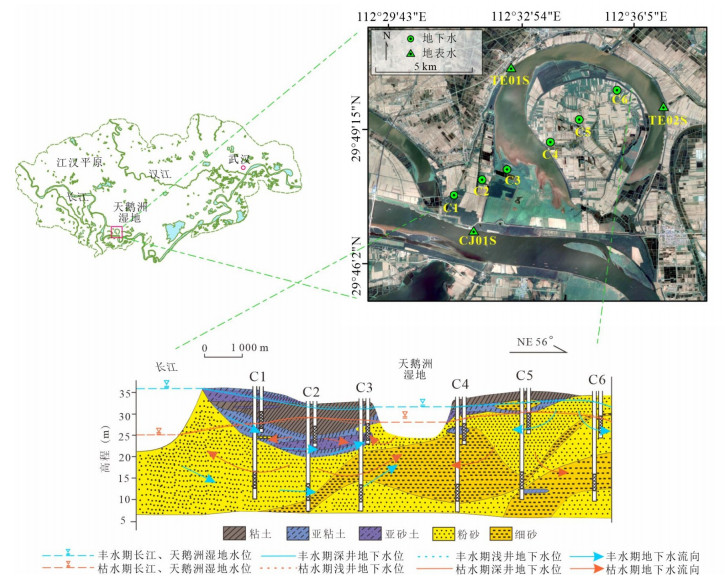
 下载:
下载:
